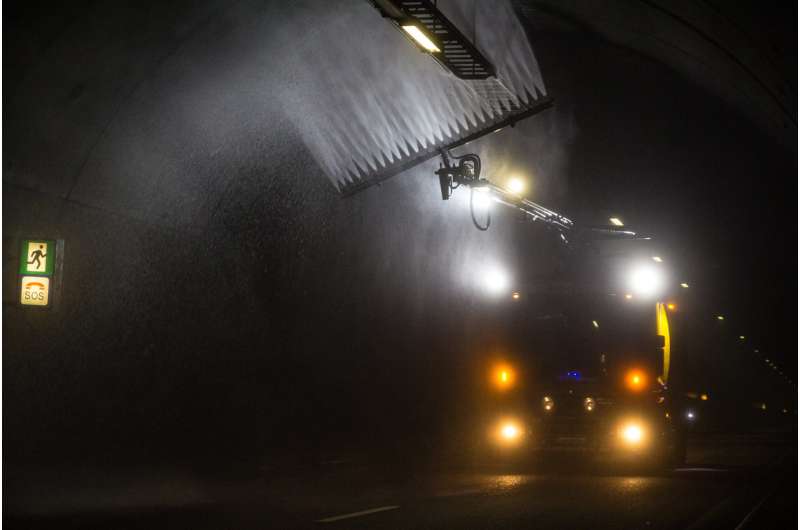Wildlife in the ditches need a detox cure

When it's raining on the roads, slopes of road dust and contaminants drain into the trenches. What impact does it have on wildlife living by the road?
Road dust is created by asphalt wearing on auto tires, the disintegration of asphalt, and exhaust from vehicles; rainfall cleanses the air, washing all the dust and particles into the ditch. Dirty rain water is usually discharged into the environment. However, some of the newly built roads have sedimentation dams, where the road runoff stands for some weeks while rubber, soot and dust sink to the bottom, protecting the surrounding environment from road contamination.
Sedimentation dams have caught the interest of Sissel Ranneklev, Merete Grung and Sondre Meland, researchers at the Norwegian Institute for Water Research (NIVA). They have spent the last few years doing research on these dams. In a recently published article, they present their findings on the health effects in animals and plants living in sedimentation dams.
"Sedimentation dams are urban habitats for a range of plants and animals, but it appears these dams also contain high levels of pollutants. Laboratory tests have shown that such contaminants have hazardous effects on for instance fish," Meland explains.
Lab fish that are exposed to polycyclic aromatic hydrocarbons (PAHs), have a higher risk of developing cancer and DNA damage. Ranneklev and Meland wanted to investigate if the effects observed in the lab also occur in sedimentation dams.
With multi-institutional colleagues, Ranneklev and Meland collected plants, frogs, sediments and minnow in a sedimentation dam that protects the river Ljanselva at Skullerud, and Sagdammen in river Ljanselva, both in the Oslo area. They also collected minnow in Østmarka southeast of Oslo for comparison. Lastly, they collected wash water during the washing of three tunnels, and brought all the samples into the laboratory for analyses. In the lab, they also did an experiment to see if wash water from tunnels affected the protein activity in liver cells, or reduced the growth of an algae called Pseudokirchneriella subcapitata.
Detox proteins and DNA brakes
Half of the minnows living in the sedimentation dam at Skullerud had broken DNA strands. DNA breaks may lead to permanent changes in the genes, at worst causing cancer. But the minnows were trying to fight back; they contained high levels of the detox protein CYP1A. This protein detoxifies toxic compounds, enhancing excretion.
"But the minnow's detox adaptation didn't work 100 percent. Rather than excreting the PAHs completely, the compounds were instead transformed to PAH metabolites," says Meland, and explains: "PAH metabolites are substances that the detox proteins produce from PAHs, and they may be just as toxic as the parent compound."
The researchers also estimated the effect of contaminated wash water on the condition of the minnows, expressed as excess energy available for the fish to grow and reproduce. The polluted fish from Skullerud had a lower condition than the unpolluted fish from Østmarka. There might be several explanations: possible higher food availability in Østmarka, higher concentrations of some compounds, or reduced energy left for food seeking and growth due to the energy costs of detoxification.
The experiment with liver cells and algae found that neither benefited from the polluted wash water. Wash water from two of the three tunnels made the algae grow more slowly, and the liver cells started producing detox proteins.
But why wash water from tunnels, and not roads? "Tunnels are interesting because they represent only local pollution sources. Other sources, like long-range transported compounds, or contaminants transported from other parts of the catchment, can be disregarded," Ranneklev explains.
Several PAH compounds that may be more toxic than those regulated by the authorities have been detected in tunnel wash water.
"Our research reveals some of the consequences of traffic pollution, and underlines the importance of sedimentation dams, where pollutants are trapped before the water is discharged into the catchments," says Ranneklev. "More research is needed for a deeper understanding of how pollution from road traffic affects the environment. One important step is to identify the amounts of microplastics that originate from tire wear."
More information: Karina Petersen et al. In vivo and in vitro effects of tunnel wash water and traffic related contaminants on aquatic organisms, Chemosphere (2016). DOI: 10.1016/j.chemosphere.2016.08.108
Merete Grung et al. PAH related effects on fish in sedimentation ponds for road runoff and potential transfer of PAHs from sediment to biota, Science of The Total Environment (2016). DOI: 10.1016/j.scitotenv.2016.05.191
Journal information: Chemosphere , Science of the Total Environment
Provided by Norwegian Institute for Water Research


















